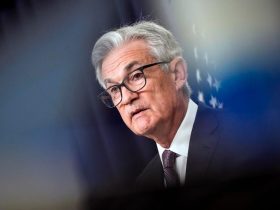Gold appears resilient amid the recent surge in real interest rates, presenting a buying opportunity over the intermediate term, according to Morgan Stanley’s wealth-management business.
“Like equities, which have continued to shrug off the negative implications of rising real rates, gold
GC00,
which moves inversely to real rates and in turn to the U.S. dollar
DXY,
has remained extremely resilient,” said Lisa Shalett, chief investment officer at Morgan Stanley Wealth Management, in a note Monday.
“Regarding the intermediate outlook, we are buyers of gold on weakness or declines in rates,” she wrote.
Real rates, which adjust for inflation, have recently jumped. While that eroded equity valuations this month, the U.S. stock market remains solidly higher for the year to date.
“The surge in real rates has been a multifactor move likely to force investors to contemplate valuation risks of a ‘higher-for-longer’ rate regime,” said Shalett. “The 10-year real rate rose above 2.0% last week, its highest since the Great Financial Crisis.”
The real rate of the 10-year Treasury note, “the fundamental ‘risk-free’ benchmark underpinning most valuation calculations across capital markets,” has jumped almost a half percentage point in the past six weeks. The rise appears “at least partially durable” as it has been driven by factors including Treasury issuance that’s higher than anticipated, credit-ratings downgrades, stronger economic growth, and policy uncertainty, according to the note.
Read: U.S. AAA debt rating gets a downgrade by Fitch; White House says move ‘defies reality’
Meanwhile, the SPDR Gold Shares ETF
GLD
is up more than 5% so far this year, even with a drop this month of around 2%, according to FactSet data, at last check. Gold futures
GC00,
have pulled back 3.2% in August, and are up 6.5% in the year to date, based on the most actively traded contract.
The yellow metal’s resilience may be linked to the view that the move higher in rates is temporary and “purely technical,” said Shalett. Another theory is that gold is “holding up as an alternative currency at a time when the dollar is vulnerable to debasement from inflation and ballooning deficit-financed spending.”
The U.S. stock market also remains up this year despite being rattled in August by rising rates.
The Dow Jones Industrial Average
DJIA
has gained more than 4% in 2023, while the S&P 500
SPX
has risen around 15.5% and the technology-heavy Nasdaq Composite
COMP
has soared almost 31%, according to FactSet data, at last check.
“Upside surprises on growth, inflation progress and earnings resilience have rewarded bulls in 2023,” said Shalett. But she cautioned that “real rates of 1.5% to 2.0% have historically been correlated with price/earnings ratios close to 17, as opposed to the current 20 times forward earnings estimates.”
Read the full article here












Leave a Reply